Increased differentiation properties in two- and three-dimensional coculture of hepatocytes and liver epithelial cells by a novel quantitative functional liver assay
Author(s)
Moritz, Joseph M. (Joseph Michael)
DownloadFull printable version (15.47Mb)
Other Contributors
Massachusetts Institute of Technology. Dept. of Chemical Engineering.
Advisor
Linda G. Griffith and James L. Sherley.
Terms of use
Metadata
Show full item recordAbstract
Hepatic stem cells in adult rats are activated by chemical injury to the liver, causing hepatic progenitor cells to proliferate, integrate into the hepatic plates, and differentiate into hepatocytes. In an attempt to model this process in vitro, we established and quantitatively assayed the differentiation properties of a strain of rat liver epithelial cells (LEC), lig8, grown in coculture with mature liver cells in a three dimensional, perfused microreactor optimized for hepatocyte culture. Lig8 was derived by suppression of the asymmetric growth kinetics that may be indicative of stem cells, and Lig8 progeny can be induced to exhibit several hepatocyte-specific differentiation properties in vitro; however, Lig8 full hepatocyte functional differentiation in culture has not yet been achieved. We hypothesized that more extensive differentiation properties may be observed in vitro if the Lig8 cells are cultured in an engineered analog of the 3D tissue environment that influences progenitor cell differentiation in vivo. We also assayed the differentiation properties of the hepatocytes in coculture. Previous studies have shown an increase in the differentiation of hepatocytes in 2D hepatocyte-LEC cocultures; we wished to determine if the benefit of coculture also occurs in the 3D microreactor. (cont.) We therefore compared the differentiation properties of both cell types in 3D microreactor cocultures to three more traditional culture formats: 2D rigid collagen monolayer, 2D collagen gel sandwich, and 3D spheroids. To assess the functional differentiation state of both cell types in these cocultures, we implemented a cell-localizable quantitative assay for endocytotic uptake of fluorescent ligands of the hepatocyte asialoglycoprotein receptor (ASGPR). T'o additionally assay overall differentiation of the cultures, we examined the level of expression compared to in vivo of three hepatocyte-specific transcripts: ASGPR, and two highly abundant drug-metabolic enzymes CYP3A1 and CYP2E1. Of all the culture modes tested, three-dimensional microreactor coculture was shown to be the most highly differentiated by the fluorescent ligand uptake assay for ASGPR and CYP3A1, with near in vivo expression of CYP3A1. However, coculture only improved the expression of the transcripts for ASGPR and CYP2E1 in 2D rigid collagen monolayer cocultures. lig8 exhibited no uptake of the ASGPR-ligand in monoculture, but in all cocultures tested, rare cells were found positive, with a higher percentage of lig8 taking up the ligand in 31) than in 2D (although cell fusion was not ruled out). (cont.) We conclude that this three-dimensional coculture system may be more physiological in vitro model for the study of LEC-mature cell interactions and liver response to carcinogens.
Description
Thesis (Ph. D.)--Massachusetts Institute of Technology, Dept. of Chemical Engineering, 2007. Includes bibliographical references (leaves 100-121).
Date issued
2007Department
Massachusetts Institute of Technology. Department of Chemical EngineeringPublisher
Massachusetts Institute of Technology
Keywords
Chemical Engineering.